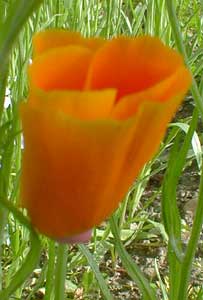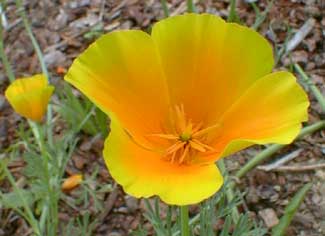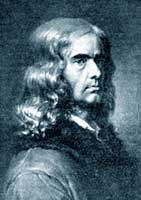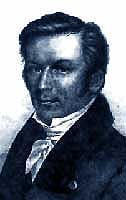
California
Golden
Poppy
"Poppy petals fall
Softly, quietly,
Calmly.
When they are ready."
-Etsujin
(1656?-1739)
(1656?-1739)
The wild California Poppy (Eschscholzia californica) is a self-seeding annual, or shortlived & tender perennial, planted along dry roadside areas all over tarnation. We ended up with a few on our roadside from a scattering of mixed wildflower seeds.
The state flower of California since 1890 has a natural range from the Sierra Mountain foothills to dry coastal areas of California, Oregon, & the Columbian River Valley of Washington state. In the past century it has extgended far beyond its west coast borders, & is today found in the majority of American states, including Hawaii.
It is in some places outside its original range regarded as an invasive pest. When we get around to planting any of these on purpose, we'll select cultivars such as the bright red varieties, which are less apt to be invasive & are not so much over-used. The ones that popped up on our roadside (from meadow-hardy & idly scattered mixed wildflower seeds) were nearly all the golden yellow wild poppy, but there were a couple of bright red California poppies too.
 It does not transplant well & should always be grown from seed. Further south they can be seeded in Autumn, but here on Puget Sound it is best to plant the seeds in late winter or early spring, after the last threat of a frost. The seeds can be scattered on the surface of lightly disturbed soil, with a thin covering of loamy soil to keep the seeds from being eaten by birds.
It does not transplant well & should always be grown from seed. Further south they can be seeded in Autumn, but here on Puget Sound it is best to plant the seeds in late winter or early spring, after the last threat of a frost. The seeds can be scattered on the surface of lightly disturbed soil, with a thin covering of loamy soil to keep the seeds from being eaten by birds.Although highly drought tolerant, seedlings will develop most rapidly & in greater numbers if the soil is kept moist (not wet) for the first couple of weeks (spring rainfall does the trick in our zone). They will be obviously visible in three weeks. In our zone they start blooming as early as May, & continue June through September.
This poppy has been used as a diuretic & as a sedative, in particular for children. The sap has been used as a toothache remedy, or rubbed on the breasts to suppress milk production for women who did not wish to nurse their newborns.
 Whether these uses are wise or effective is difficult to gauge. The species is not well-studied to assess whether or not these purported values are slight or definite, or what health hazards might be if it were overused.
Whether these uses are wise or effective is difficult to gauge. The species is not well-studied to assess whether or not these purported values are slight or definite, or what health hazards might be if it were overused. It was named by Adelbert von Chamisso (1781-1838) , botanist, poet, & author of the great fantasy tale of Peter Schlernihl, The Man without a Shadow (1813).
It was named by Adelbert von Chamisso (1781-1838) , botanist, poet, & author of the great fantasy tale of Peter Schlernihl, The Man without a Shadow (1813).In 1815 Chamisso set out as the official naturalist on a scientific voyage that circled the globe. His portrait is shown here on the left.
This was on the Russian ship Rurik which among so many other places explored the coast from Alaska to California.
When Chamisso found & described the California poppy, he immediately thought to name it for his fellow botanist, Johann Friedrich Eschscholtz (1793-1831), an Estonian physician who was the Rurik's surgeon on that same voyage of discovery. Dr. Eschscholtz's portrait is on the right.